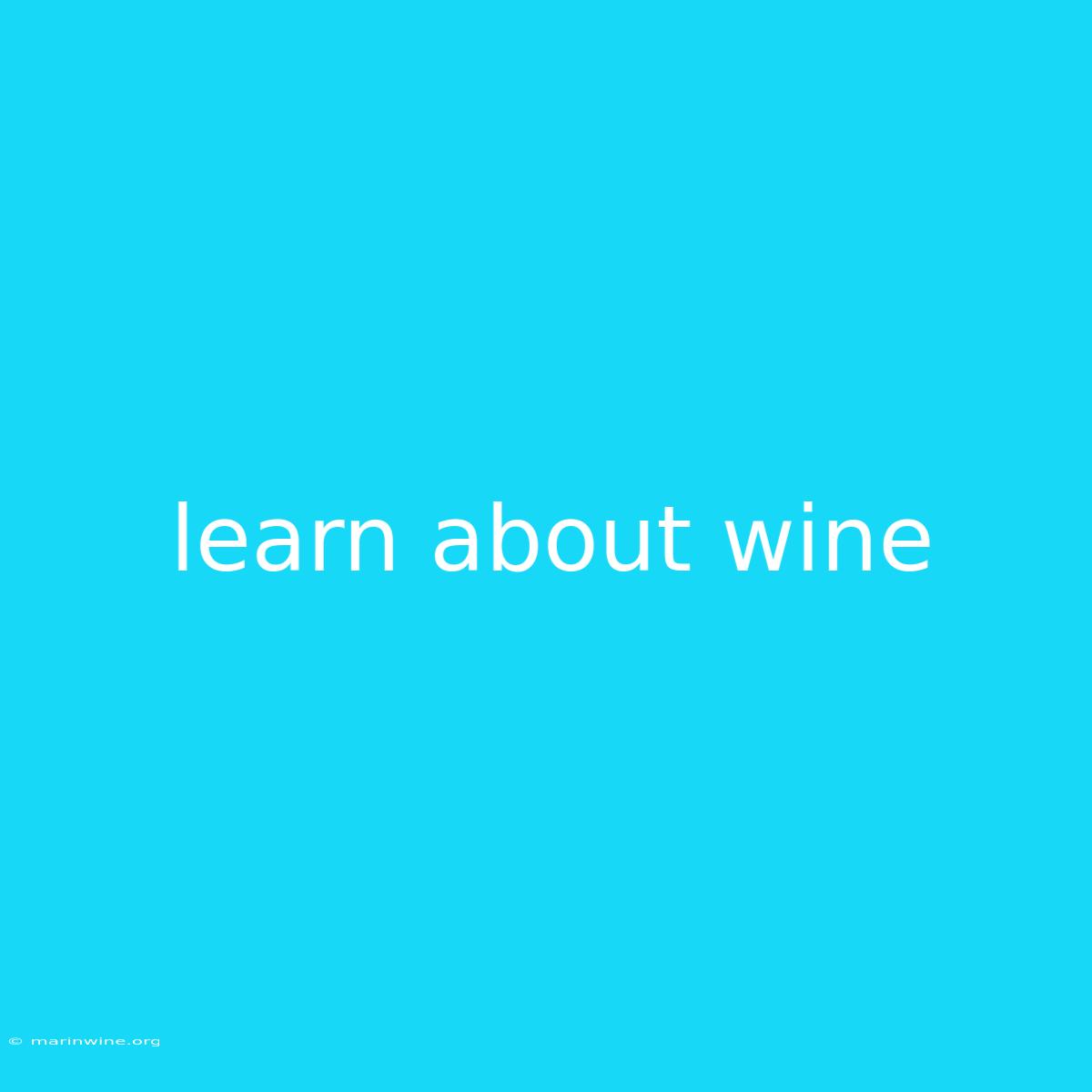Uncorking the World of Wine: Discover the Delights and Nuances of Wine Appreciation
Editor’s Note: Are you intrigued by the world of wine but feel overwhelmed by the endless options and unfamiliar terminology? This article will guide you through the fascinating journey of learning about wine, revealing the secrets behind this beloved beverage.
Why It Matters: Wine has been enjoyed for centuries, transcending cultures and generations. Understanding the basics of wine can enrich your dining experiences, deepen your appreciation for food pairings, and spark engaging conversations.
Key Takeaways:
| Takeaway | Description |
|---|---|
| Grapes and Regions: Wine is made from different grape varieties, each region cultivating its own unique blend. | |
| Tasting Notes: Understanding the flavors and aromas of wine enhances the experience. | |
| Food Pairings: Pairing wine with food creates a harmonious symphony of taste. | |
| Wine Storage: Proper storage ensures wine's longevity and quality. |
Understanding the World of Wine
Wine is an incredibly diverse and multifaceted beverage. Delving into its complexities can be both rewarding and enjoyable.
Key Aspects:
-
Grape Varieties: Wine begins with the grape. Each variety possesses distinctive characteristics, influencing flavor, aroma, and color. From classic Cabernet Sauvignon to delicate Pinot Grigio, understanding grape varieties is crucial to appreciating wine.
-
Regions and Terroir: A region's climate, soil, and topography influence a wine's character. For example, the sun-drenched vineyards of Bordeaux produce robust red wines, while the cool climate of Burgundy yields elegant Pinot Noirs.
-
Winemaking Process: The art of winemaking involves steps like harvesting, crushing, fermentation, and aging. These techniques impact a wine's final profile, adding complexity and depth.
Grape Varieties
Introduction: The journey begins with the grape. Different grape varieties possess unique characteristics, influencing flavor, aroma, and even color.
Facets:
- Red Grapes: Cabernet Sauvignon, Merlot, Pinot Noir, Syrah, Zinfandel, Malbec, Sangiovese, Grenache.
- White Grapes: Chardonnay, Sauvignon Blanc, Pinot Grigio, Riesling, Viognier, Moscato, Chenin Blanc.
- Rosé Grapes: Grenache, Syrah, Mourvèdre, Pinot Noir, Zinfandel.
Summary: Exploring the world of grape varieties broadens your appreciation of the diverse range of wine styles available.
Regions and Terroir
Introduction: The connection between a wine and its origin is deeply intertwined. Terroir, the unique combination of climate, soil, and topography, contributes significantly to a wine's character.
Facets:
- Climate: Sunlight, temperature, and rainfall greatly influence grape growth and maturation.
- Soil: Soil composition affects the grapes' flavor and aroma profiles.
- Topography: Altitude, slope, and proximity to water bodies impact the vineyard's microclimate.
Summary: Understanding terroir allows you to appreciate the geographic origins of wine and the specific influences that contribute to its character.
Winemaking Process
Introduction: From harvest to bottle, winemaking is a complex process that transforms grapes into the liquid we enjoy.
Further Analysis:
- Harvesting: Grapes are harvested at peak ripeness, ensuring optimal flavor and sugar content.
- Crushing: Grapes are crushed to release juice, skins, and seeds.
- Fermentation: Yeast converts sugar into alcohol, creating the backbone of wine.
- Aging: Wine matures in oak barrels or stainless steel tanks, developing its complexity and flavor.
Closing: Understanding the winemaking process sheds light on the factors influencing the final flavor profile.
Information Table: Wine Styles
| Style | Characteristics | Examples |
|---|---|---|
| Red Wine | Full-bodied, often robust and tannic. | Cabernet Sauvignon, Merlot, Pinot Noir, Syrah. |
| White Wine | Crisp, refreshing, and often light-bodied. | Chardonnay, Sauvignon Blanc, Riesling, Pinot Grigio. |
| Rosé Wine | Light and fruity, with varying shades of pink. | Grenache, Syrah, Pinot Noir, Zinfandel. |
| Sparkling Wine | Fizzy, with delicate bubbles. | Champagne, Prosecco, Cava. |
| Fortified Wine | Sweet or dry, fortified with alcohol during the winemaking process. | Port, Sherry, Madeira. |
FAQ for Wine
Introduction: Let's address some common questions about the world of wine.
Questions:
- Q: How do I choose a wine? A: Consider your personal preferences, the occasion, and the food you're pairing it with.
- Q: What does "dry" wine mean? A: It refers to a wine with little or no residual sugar.
- Q: How do I taste wine? A: Start by swirling the wine in the glass, sniffing the aromas, and taking a small sip.
- Q: What's the best way to store wine? A: Wine should be stored in a cool, dark place at a consistent temperature.
- Q: How long does wine last? A: Opened wine can last several days, while unopened wine can be aged for years.
- Q: What are tannins? A: Tannins are compounds found in grape skins and seeds that provide structure and astringency to wine.
Summary: Exploring the FAQs helps demystify the world of wine, making it more accessible to enthusiasts.
Tips for Wine Appreciation
Introduction: Enhance your wine journey with these practical tips.
Tips:
- Start with Simple Wines: Begin with familiar and approachable wines to develop your palate.
- Join a Wine Tasting: Attend a wine tasting to explore different varieties and learn from experts.
- Visit a Winery: Experience the winemaking process firsthand and discover regional specialties.
- Read Wine Reviews: Explore online resources and publications to gain insights from wine critics.
- Experiment with Food Pairings: Discover the delightful combinations that enhance both food and wine.
- Take Notes: Document your tasting experiences to track your preferences and discoveries.
Summary: These tips provide valuable guidance for enriching your wine journey.
Summary by Wine Appreciation
Uncorking the world of wine reveals a fascinating landscape of aromas, flavors, and cultural influences. This article has explored the fundamental aspects of wine, including grape varieties, regions, winemaking processes, and common questions. By understanding these elements, you can embark on a rewarding journey of wine appreciation.
Closing Message: As you venture deeper into the world of wine, remember that the key is to explore, experiment, and discover your personal preferences. Let your curiosity guide you, and enjoy the journey!

